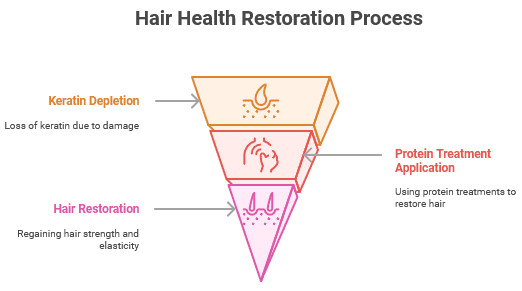Many different external factors can cause hair damage, from sun exposure to styling techniques using heat, and even an unbalanced diet. The worst thing is that these factors don’t just cause surface-level issues like dryness and fraying – they actually damage it on a much deeper level.
Prolonged exposure to these detrimental effects slowly destroys keratin, the main protein responsible for strong and healthy strands. That’s why a proper hair care treatment using proteins can help rejuvenate the hair and bring back its youthful shine and elasticity. We will go over how such treatments work, when to use them, and provide some useful alternatives.
The Science Behind Hair Protein and Hair Loss
The hair is mostly made up of a specific type of protein, keratin, which gives it a semi-rigid structure, with enough elasticity to withstand daily contact with the environment.
However, when there is a low amount of protein in a person’s diet, the body prioritizes vital organs. That’s why each hair follicle gets fewer resources, leading to thinner and more easily damaged strands. It will also be much slower to regrow and may shed more.
Although the key ingredients in protein hair treatments, keratin and collagen, provide direct support, it’s also important to get enough lean protein from your diet. With that in mind, let’s look at when this option can work best.

When Protein Treatments Are (and Aren’t) the Solution
These can be a great solution if you have dry or thin hair strands, as proteins can help keep things moisturized and coat the shaft to add some volume. A specialized conditioning mask can also be useful for healing damage from curling irons, hair dryers, or chemical styling methods.
However, if you are experiencing noticeable hair loss, with a receding hairline, bald spots or excessive thinning at the top of the head, then you will need a different approach.
Protein Treatments as Part of Pre- and Post-Transplant Hair Care
Using hair treatment masks before an operation can actually make the donor grafts thicker and more resilient to breakage, leading to higher survival rates. During the recovery period, it can also help improve hair volume and give you a fuller look. However, it will only be useful after about the first 3 or 4 months, after the initial shock loss, when the new strands start growing out again.
Top Protein Treatments Recommended by Hair Restoration Experts
You now have a good idea about the basic science behind protein-based products and when to use them, so it’s time to go over the best available options and see how they compare.
Treatment Type | Best for Hair Type | Key Benefits | Cautions |
Wheat Protein Masks | Color-treated or porous | Penetrates the shaft to strengthen hair, improves manageability | Can cause dryness if overused |
Hydrolyzed Keratin Masks | Damaged or coarse | Repairs cuticle, restores shine and resilience | Needs added moisture care |
Collagen + Amino Acids Conditioners | Fine and thinning | Boosts elasticity and supports scalp health | Benefits are mostly cosmetic |
Amino Acid Leave-in Sprays | Fragile or oily | Protects against breakage | Less intensive than deep masks |
Protein-enriched Deep Conditioning Masks | Dry and brittle | Combine protein + moisture for balanced repair | Overuse can cause buildup or stiffness |
When to Consider a Hair Transplant
It’s always a good idea to first try out a few different non-invasive methods to see if you can make a significant impact on your hair. However, most of these, protein-rich topical products included, cannot help with extensive balding. If you have a family history of male or female pattern baldness or excessive thinning, you may want to consider getting a hair transplant in Turkey.
FAQs
Can protein treatments stop hair loss?
Unfortunately, as all of the options we’ve listed only impact the hair shaft and not the follicle, they won’t be able to slow down or stop further shedding. However, they can make the existing strands look much healthier.
Will they help with thinning hair?
By making the hair stronger and adding a bit of thickness to each individual strand, these treatments can give you a fuller, denser look, but they won’t fill in the gaps where your hair has already fallen out.
Can they help regrow hair?
While protein treatments for hair are definitely useful for reducing breakage and fraying, they simply don’t affect the roots in any meaningful way. That’s why they won’t be able to promote new growth. You will need to turn to proven methods like FUE hair transplants if you have large bald areas that need to be filled out.

